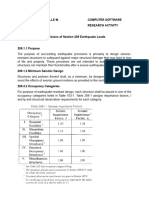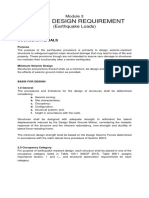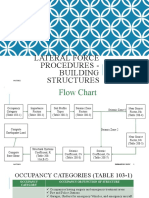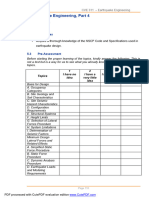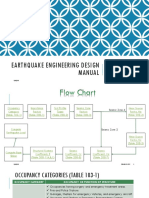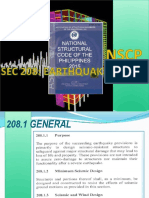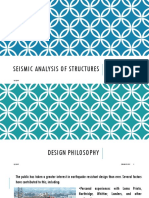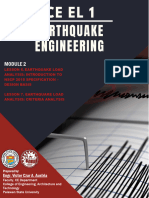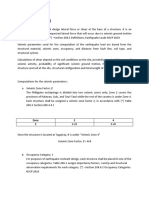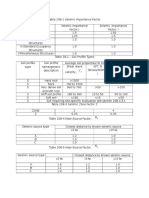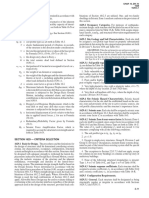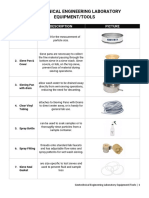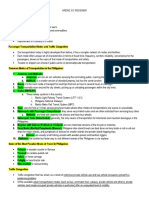0 ratings0% found this document useful (0 votes)
75 views54 pagesEarthquake Engineering Code
Uploaded by
Erika TolentinoCopyright
© © All Rights Reserved
We take content rights seriously. If you suspect this is your content, claim it here.
Available Formats
Download as PDF or read online on Scribd
0 ratings0% found this document useful (0 votes)
75 views54 pagesEarthquake Engineering Code
Uploaded by
Erika TolentinoCopyright
© © All Rights Reserved
We take content rights seriously. If you suspect this is your content, claim it here.
Available Formats
Download as PDF or read online on Scribd
You are on page 1/ 54
2:14 CHAPTER 2 - Minimum Design Loads
SECTION 208
EARTHQUAKE LOADS
208.1 General
208.11 Purpose
‘The purpose of the succeeding earthquake provisions is
primarily to design seismic-resistant structures to
safeguard against major structural damage that may lead to
loss of life and property. These provisions are not intended
to assure zero-damage to structures nor maintain their
functionality after a severe earthquake.
2081.2 Minimum Seismie Desiga
Structures and portions thereof shall, as a minimum, be
designed and constructed 10 resist the effects of seismic
ground motions as provided in this section.
208.13 Seismic and Wind Design
When the code-prescribed wind design produces greater
effects, the wind design shall govern, but detailing
requirements and limitations prescribed in this section and
referenced sections shall be made to govern.
208.2 Definitions
See Section 202,
208.3 Symbols and Notations:
e
fl
ground floor area of structure to include area
covered by all overhangs and projections, m?
the combined effective area of the shear walls in
the first storey of the structure, m?
the minimum cross-sectional area in any
horizontal plane in the first storey ofa shear wall,
the torsional amplification factor at Level x
‘numerical coefficient specified in Section 208.7
and set forth in Table 208-13
seismic coefficient, as set forth in Table 208-7
numerical coefficient given in Section 208,5.2.2
seismic coefficient, as set forth in Table 208-8
dead load
J. = the length of a shear wail inthe first storey in the
direction parallel to the applied forces, m
E.EyEm Ey = earthquake loads set forth in Section
208.6
F, = design seismie force applied to Level &, n or x,
respectively
Fy ~ design seismic force on a part ofthe structure
Fp design seismic foree on a diaphragm
>
1
>
"
that portion of the base shear, V, considered,
concentrated at the top of the structure in addition
toFy
lateral force at Level é for use in Equation 208.
fi ag
g _ = acceleration due to gravity ~ 9.815 m/sec
Iiyly Itz = height above the base to Level i, m or x,
respectively, m
1 importance factor given in Table 208-1
Ty = importance factor for nonstructural component as
given in Table 208-1
L = liveload
Level i = level of the structure refered to by the
subscript é
“i = 1” designates the first level above the base
Levelm = that level that is uppermost in the main
portion of the structure
Levelx = that level that is under design consideration
Sx. = IP designates the first evel above the base
M_— = maximum moment magnitude
Nq = near-source factor used in the determination of Cy
in Scismie Zone 4 related to both the proximity of
the building or structure to known faults with
‘magnitudes as set forth in Tables 208-4 and 208-5
N= neat-sourve factor used in the determination of Cy
in Seismic Zone 4 related to both the proximity of
the building or structure to known faults with
magnitudes as set forth in Tables 208-4 and 208-6
PI ~ plasticity index of soil determined in accordance
with approved national standards
R= numerical coefficient representative ofthe inherent
over-strengih and global ductility capacity of
Jaterl-force-resisting systems, as set forth in Table
208-11 or 308-12
r =a ratio used in determining pLicithe
redundancy/reliaility factor. See Section 20835.
Sw SeScSoSeS- — ~ soil profile types as set forth
in Table 208-2
T = elastic fundamental period of vibration of the
structure in the direction under consideration,
v base shear given by Equations, 208-8, 208-9,
208-10, 208-11 or 208-15
V, = the design storey shear in Storey x
W = the total seismic dead load defined in Section
208.5.2.1
W;,Wy = that portion of W located at or assigned to
Level for x, respectively
W, = the weight of an element or component
Wyx ~ the weight of the diaphragm and the element
tributary thereto at Level x, including applicable
portions of other loads defined in Section
2086.1
Z = seismic zone factor as given in Table 208-3,
Association of Structural Engineers of the Philippines, Inc. (ASEP)
‘Sy = Maximum Inelastic Response Displacement,
which is the total drift or total storey drift that
occurs when the structure is subjected to the
Design Basis Ground Motion, including
estimated elastic and inelastic contributions to
the total deformation defined in Section
208.6.4.2, mm
Design Level Response Displacement, which is
the total drift or total storey drift that occurs
when the structure is subjected to the design
seismie forces, mm
horizontal displacement at Level {relative to the
base due to applied lateral forces, f;, for use in
Equation 208-14, mm
Redundaney/Reliability Factor given by
Equation 208-20
Seismic Force Amplification Factor, which is
required to account for structural over-strength
and set forth in Table 208-11
208.4 Basis for Design
2084.1 General
‘The procedures and the limitations for the design of
structures shall be determined considering seismic zoning,
site charaeteristies, occupancy, configuration, structural
system and height in accordance with this section,
Structures shall be designed with adequate strength to
‘withstand the lateral displacements induced by the Design
Basis Ground Motion, considering the inelastic response of
the structure and the inherent redundancy, over-strength
and ductility of the lateral force-resisting system.
‘The minimum design strength shall be based on the Design
Seismic Forces determined in accordance with the static
lateral force procedure of Section 208.5, except as
modified by Section 208.5.3.5.4,
Where strength design is used, the load combinations of
Section 203.3 shall apply. Where Allowable Stress Design
is used, the load combinations of Section 203.4 shall apply.
Allowable Stress Design may be used to evaluate sliding
‘or overtuming at the soil-structure interface regardless of
the design approach used in the design of the structure,
provided load combinations of Section 203.4 are utilized.
CHAPTER 2
finimium Desig
208.4.2 Occupancy Categories
For purposes of earthquake-resistant design, each structure
shall be placed in one of the occupancy categories listed in
‘Table 103-1, Table 208-1 assigns importance factors, J and
Ip. and. structural observation requirements. for each
category.
‘Table 208-1 - Seismic Importance Factors
Saomle | Seine
Qecupaney — | importance | importance?
vategory Factor, J Factor, Ip
1 Essential
Facilities * ia 10
1. Weardas
Facilities a 150
Speci
Occupancy Lon 100
Structures
IV. Standard |
Occupancy Lon Lo»
Stractures
V.— Misclianous
structures: eI i
" See Table 103-1 for occupancy category listing
2 The limitation of Ip for panel connections in Section
208,7.2.3 shall be 1.0 for the entire connector
® Structural observation requirements are given in Section
1079
* Foranchorage of machinery and equipment required for
life-safety systems, the value of Ip shall be taken as 1.5
208.43 Site Geology and Soll Characteristics
Each site shall be assigned a soil profile type based on
properly substantiated geotechnical data using the site
‘categorization procedure set forth in Section 208.4.3.1.1
and Table 208-2,
Exception:
When the soil properties are not known in sufficient detail
10 determine the soil profile type, Type Sp shall be used.
Soil Profile Type Sp or Sp need not be assumed unless the
building official determines that Type Sg or Sp may be
present at the site or in the event that Type Sp or Sp is
established by geotechnical data
National Structural Code of the Philippines Volume |, 7th Edition, 2015
2186 CHAPTER 2 ~ Minimum Design Loads
208.431 Soil Profile Type
Soil Profile Types $4, Sa, Se, Sp and Se are defined in
Table 208-2 and Soil Profile Type Sp is defined as soils
requiring site-specific evaluation as follows:
1. Soils vulnerable to potential failure or collapse under
seismic loading, such as liquefiable sols, quick and
highly sensitive clays, and collapsible weakly
cemented sols.
Peats and/or highly organic clays, where the thickness
of peat or highly organic clay exceeds 3.0 m.
3. Very high plasticity clays witha plasticity index, PI >
75, where the depth of clay exceeds 7.5 m.
4. Very thick soft’medium stiff clays, where the depth of
clay exceeds 35 m,
5. The criteria set forth in the definition for Soil Profile
Type Sp requiring site-specific evaluation shall be
considered. Ifthe site corresponds to these criteria, the
site shall be classified as Soil Profile Type Sp and a
site-specific evaluation shall be conducted,
208.4.3.1.1 Site Categorization Procedure
208.43.1.1.1 Scope
‘This section describes the procedure for determining Soil
Profile Types $, through Sas defined in Table 208-2.
‘Table 208-2 - Soil Profile Types
“Average Soil Properties for Top 30 m of Soil Profile
Soil Profile | Soil Profile Name / Generic es
rafleName/ Generic | Scar wane Velox, (SPT, Wot | Shear
oe se Vs (mus) 300mm) | Strength, Sy
(kPa)
Sa Hard Rock > 1500
Se Rock 760 to 1500
Se ‘Very Dense Soil and Soft Rock 360 10 760 50 > 100
Sp Stiff Soil Profile 180 t0 360 151050 30%0 100
Set Soft Soil Profile < 180 <15 <50
4 Soil Requiring Site-specific Evaluation
* ‘See Section 208.4.3.1
1 Soll Profile Type Se also includes any soll profile with more than 3.0 m of soft clay defined as a soil with plasticity index,
PI>20, Wine 2 40% and 5 < 24 kPa. The Plasticity Index, PI, and the moisture content, Wye, shall be determined
in accordance with approved national standards.
208.43.1.1.2 Definitions
Soil profile types are defined as follows:
Hard rock with measured shear wave velocity,
v, > 1500 m/s
Rock with 760 m/s < v, < 1500 m/s
Very dense soil and soft rock with 360 m/s <
¥, < 760 m/s or with either N > 50 ot 54>
100 kPa
Stiff soil with 180 m/s < vs <360m/s or
with 15 20, Wye 2 40 percent and
Sq < 25 kPa
Soils requiring site-specific evaluation, refer to
Section 208.4.3.1
Association of Structural Engineers of the Philippines, Inc. (ASEP)
208.4.3.1.1.2.1 _v,, Average Shear Wave Velocity
v, shall be determined in accordance with the following
equation:
(208-1)
where
d, thickness of Layer ¢, m
vy = shear wave velocity in Layer i, m/s
208.4.3.1.1.2.2 N, Average Field
Standard Penetration Resistance and
Neny Average Standard Penetration
Resistance for Cohesionless Soil
Layers
N and Ney shall be determined in accordance with the
following equation:
(208-2)
(208-3)
where
d= thickness of Layer i in mm
d, = the toll thickness of cohesionless soi layers
in the top 30m
1M; = the standard penetration resistance of soil
layer in accordance with approved nationally
recognized standards
208.4.3.1.12.3 sy, Average Undrained Shear
Strength
Sy shall be determined in accordance with the following.
‘equation:
Su (208-4)
Tage
d, = the total thickness (100 ~ d,) of cohesive
soil layers in the top 30:m
Sw = the undrained shear strength in accordance
with approved nationally recognized
standards, not to exceed 250 kPa
CHAPTER 2— Minimum Design Loads 2-187
208.4.3.1.
24 Rock Profiles, S, and Sz
‘The shear wave velocity for rock, Soil Profile Type Sp,
shall be cither measured on site or estimated by a
geotechnical engineer, engineering geologist or
seismologist for competent rock with moderate fracturing.
and weathering. Softer and more highly fractured and
weathered rock shall either be measured on site for shear
‘wave velocity or classified as Soil Profile Type Sc.
‘The hard rock, Soil Profile Type Sq, category shall be
supported by shear wave velocity measurement either on
site or on profiles of the same rock type in the same
formation with an equal or greater degree of weathering
and fracturing. Where hard rock conditions are known to
‘be continuous to a depth of 30m, surficial shear wave
velocity measurements may be extrapolated to assess
The rock categories, Soil Profile Types $4 and Sp, shall,
not be used if there is more than 3 meters of soil between,
the rock surface and the bottom of the spread footing or mat
foundation.
The definitions presented herein shall apply to the upper
30 m of the site profile. Profiles containing distinctly
different soil layers shall be subdivided into those layers,
designated by a number from I to m at the bottom, where
there are a total of distinct layers in the upper 30 m, The
symbol # then refer to any one of the layers between 1 and
208.4.3.1.1.2.5 Soft Clay Profile, S
The existence of a total thickness of soft clay greater than
3 m shall be investigated where a soft clay layer is defined
by Sy <24KPa, Wine > 40 percent and PI > 20. If
these criteria are met, the site shall be classified as Soil
Profile Type Ss.
208.4.3.1.12.6 Soil Profiles Se, Sp and Sy
Sites with Soil Profile Types S¢, Sp and Sp shall be
classified by using one of the following three methods with
¥, ,N and 54 computed in all cases as specified in Section
20843.11.
Lv, forthe top 30 meters (v, method)
2. N forthe top 30 meters (N method)
3. Noy for cohesionless soil layers (PI < 20) in the top
30 mand average sy for cohesive soil layers (PI >
20) in the top 30 m (Sy method).
National Structural Code of the Philippines Volume |, 7th Edition, 2015
2188 CHAPTER 2 ~ Minimum Design Loads
2084.4 Site Seismic Hazard Characteristics Table 208-4 - Seismic Source Types '
Seismic hazard characteristics for the site shall_ be Scismie Source
‘established based on the seismic zone and proximity of the Seismic Definition
site to active seismic sources, site soil profile Source | Seismic Source |__|
characteristics and the structure's importance factor. "Type scription | Maximum Moment
Magnitude, M
208.4.4.1 Seismic Zone }_—_}_ _}_____}
Faults that are
The Philippine archipelago is divided into two seismic capable of
zones only. Zone 2 covers the provinces of Palawan producing large
(except Busuanga) , Sulu and Tawi-Tawi while the rest of A magnitude events | 705M <8.4
the country is under Zone 4 as shown in Figure 208-1. Each and that have a
structure shall be assigned a seismic zone factor Z, in high rate of seismic
accordance with Table 208-3 activity
Table 208-3 Seismic Zone Factor Z ‘All faults other
a 3 7 B than Types Aand | 655 M<7.0
Z 0.20 0.40 7
Faults that are not
208.4.4.2 Seismic Source Types capable of
Table 208-4 defines the types of selmi sources, The producing large
location and type of seismic sources to be used for design c eceeaetiod M<65
shall be established based on approved geological data; see furs
Figure 208-2A. Type A sources shall be determined from senna cate
Figure 208-2B, 2C, 2D, 2E or the most recent mapping of of sclemie activity
‘active faults by the Philippine Institute of Volcanology and ote
Seismology (PHIVOLCS) 'Subduction sources shall be evaluated on a site-
specific basis.
Association of Structural Engineers of the Philippines, Inc. (ASEP)
CHAPTER 2—Mininum Design Loads 2-189
ww = wr mr m88
oo
a
Figure 208-1 Referenced Seismic Map of the Philippines
National Structural Code of the Philippines Volume I, 7th Edition, 2015,
2.190
CHAPTER 2 ~ Minimum Design Loads
Distribution of Active Faults and Trenches
in the Philippines
of
Figure 208-2A Distribution of Active Faults and Trenches in the Philippines
‘Association of Structural Engineers of the Philippines, Inc. (ASEP)
==
Figure 208-28 Distribution of Active Faults in Cordillera Administrative Region (CAR)
National Structural Code of the Philippines Volume I, 7th Ealtion, 2015
2492
CHAPTER 2 ~ Minimum Design Loads
Pct moe Cee Cee
in Region 1
iis Boe T
==
| ed
+ = |.
@ ho
—— \ ao
Figure 208-2C Distribution of Active Faults and Trenches in Region 1
Association of Structural Engineers of the Philippines, Inc. (ASEP)
CHAPTER 2 ~ Minimum Design Loads
Figure 208-2D Distribution of Active Faults and Trenches in Region 2
National Structural Code of the Philippines Volume |, 7th Edition, 2015
2193
2-194 CHAPTER 2 - Minimum Design Loads,
a
Gy
S
3
:
o
IRS Tae YA oh Co Lest Lae [ONC IT]
Figure 208-2E Distribution of Active Faults in Region 3
‘Association of Structural Engineers of the Philippines, Inc. (ASEP)
HAPTER 2 — Minimum Design Lox
Distribution of Active Faults and Trenches
in Region 4A
Figure 208-2F Distribution of Active Faults and Trenches in Region 44,
National Structural Code of the Philippines Volume |, 7th Edition, 201
2.196 CHAPTER 2 ~ Minimum Design Loads
Figure 208-2F Distribution of Active Faults and Trenches in Region 4B
Association of Structural Engineers of the Philippines, Inc. (ASEP)
Figure 208-2E Distribution of Active Faults in Region 5
National Structural Code of the Philippines Volume |, 7th Edition, 2015,
2-498 CHAPTER 2— Minimum Design Loads
Distribution of Active Faults and Trenches in Region 6
Figure 208-2F Distribution of Active Faults and Trenches in Region 6
Association of Structural Engineers of the Philippines, Inc, (SEP)
CHAPTER 2.» Mininuon Design Loads 2.4
Distribution of Active Faults in Region 7
Figure 208-2G Distribution of Active Faults in Region 7
National Structural Code of the Philippines Volume |, 7h Edition, 2015
2.200 CHAPTER 2 - Minimum Design loads
Distribution of Active Faults in Region 8
Figure 208-2H Distribution of Active Faults in Region 8
Association of Structural Engineers ofthe Philippines, Inc, (ASEP)
2.201
CHAPTER 2 — Minimum Design Loads
‘National Structural Code of the Philippines Volume I, 7h Edition, 2015,
(Tha) Cre PUTS ed TEST) ETN retro tang
ul Sayouady puke syney aanoy yo uoNNquysiq
Figure 208-21 Distribution of Active Faults and Trenches in Autonomous Region of Muslim Mindanao (ARMM)
Distribution of Active Faults and Trenches in Region 9
Figure 208-25 Distribution of Active Faults and Trenches in Region 9
Association of Structural Engineers of the Philippines, Ine, (ASEP)
CHAPTER 2 — Mini
Figure 208-2K Distribution of Active Faults and Trenches in Region 10
National Struotural Code of the Philippines Volume |, 7th Edition, 2015,
2-204 CHAPTER 2~ Minimum Design Loads
ibution of Active Faults and Trench
in Region 11
lr
Figure 208.21. Distribution of Active Faults in Region 11
‘Association of Structural Engineers of the Philippines, Inc. (ASEP)
CHAPTER 2 Minimum Design Loads 2.205,
Distribution of Active Faults and Trench
Region 12
Figure 208-2M Distribution of Active Faults and Trenches in Region 12
National Structura! Code of the Philippines Volume f, 7th Edition, 2015
a
2-208
CHAPTER 2 Minimum Design Loads.
PY Gene nama CRU MCL
Figure 208-2N Distribution of Active Faults and Trenches in Region 13
Association of Structural Engineers of the Philippines, Inc. (ASE!
208.4.4.3. Seismic Zone 4 Near-Source Factor
In Seismic Zone 4, each site shall be assigned near-souree
factors in accordance with Tables 208-5 and 208-6 based
‘on the Seismic Source Type as set forth in Section
208.4.4.2.
For high rise structures and essential facilities within
2,0 km ofa major fault, a site specific seismic elastic design
response spectrum is recommended to be obiained for the
specific area
CHAPTER 2~ Minimum Design Loads 2-207
4. The exceptions to Section 15.6.5 shall not apply,
except for columns in one-storey buildings or columns:
atthe top storey of multistorey buildings.
5. None of the following structural irregularities. is
present: Type 1,4 or $ of Table 208-9, and Type | or
4 of Table 208-10.
2084.44 Seismic Response Coefficients
Each structure shall be assigned a seismic coefficient, Ca
in accordance with Table 208-7 and a seismic coefficient,
Table 208-5 Near-Source Factor Ng ' Goo seconde va Table 208-8
‘Table 208-7 Seismic Coefficient, Cy
Soil Profile Seismic Zone Z
Type Z=04
Sa 0.32N,
Sa ‘O.40N,
Se ‘0.40N,
‘Table 208-6 Near-Source Factor, Ny ' Sa O44
— Sr 0.44N,
Seismic Closest Distance To
Souree | ___Known Seismic Source? St Sew otnotel af Tablet 208%
Type | =2km | Skm | 10km | S1Skm
rn 20 16 1 1 10 Table 208-8 Seismic Coefficient, Cy
B 16 12 [10 10 Soil Profile Seismic Zone Z
c 10. 10 [10 10. ‘Type Z=02 Z=04
Notes for Tables 208.5 and 208.6: Sa 06 032Nr
"The Near-Source Factor may be based on the linear 5; 0.20 ——.40N
interpolation of values for distances other than those S 032 0.56
Shown in the table. Sp |. 0.40 DAN
5 0.64 0.96Nr
2 The closest distance t0 seismic source shall be taken £
4s the minimum distance between the site and the area Se See Roccnote laf Tailes2085,
described by the vertical projection of the source on
the surface (ie., surface projection of fault plane). The
surface projection need not include portions of the
source at depths of 10 km or greater. The largest value
of the Near-Source Factor considering all sources
shall be used for design.
‘The value of Nq used to determine C, need not exceed 1.1
for structures complying with all the following conditions:
1. The soil profile type is $4, $n, S¢ Or Sp.
2 p= 10.
3. Except in single-storey structures, residential building
accommodating 10 or fewer persons, private garages,
carports, sheds and agricultural buildings, moment
frame systems designated as part of the lateral-force-
resisting. system shall be special moment-resisting
frames.
» Site-specific geotechnical investigation and dynamic site
response analysis shall be performed to determine
seismic coefficients
2084.8 Configuration Requirements
Each structure shall be designated as being structurally
regular or irregular in accordance with Sections 208.4.5.1
and 208.452
208.481 Regular Structures
Regular structures have no significant physical
discontinuities in plan or vertical configuration or in their
Iateral-force-resisting systems such as the iregular features
described in Section 208.4.5.2.
National Structural Code of the Philippines Volume |, 7th Edition, 2015,
a
2.208 CHAPTER 2 Minimum Design Loads
208.4.5.2 Irregular Structures
1, Invegular structures have significant physical
discontinuities in configuration or in theit lateral-
force-resisting systems. Iregular features include, but
are not limited to, those described in Tables 208-9 and
208-10, All structures in occupancy Categories 4 and
5S in Seismic Zone 2 need to be evaluated only for
vertical imegularities of Type 5 (Table 208-9) and
horizontal itregulaities of Type 1 (Table 208-10).
2. Structures having any of the features listed in Table
208-9 shall be designated as if having a vertical
ieregulaity.
Exception:
Where no storey drift ratio under design lateral forces is
‘greater thar 1.3 tines the storey drift ratio of the storey
labove, the structure may be deemed 10 not have the
‘iructural tregularties of Type 1 or 2 in Table 208-9. The
siorey dif ratio for the top two stories need not be
considered. The storey drifts for this determination may be
calculated neglecting torsional effets.
3. Structures having any of the features listed in Table
208-10 shall be designated as having a plan
irregularity.
‘Table 208-9 Vertical Structural Irregularities
irregularity Type and Definition | Reference
I, Stiffness Irregularity — Soft \- |
Storey
Ast sire is one in whi the
tral nesses than 7056 | 708483
that in the storey above or less than
80 percent of the average stiffness
of the three stories above.
2 Weight (is) erly
Mass irregularity shall_—-be
Smee fo exit ete the
‘anve macs ofery storey sre | 708483
tan 130 ofthe ceive mar of
araiacen sory. A tot tat
ig han te Row low oe
nut beconideed
3. Vertical Geometric Irregularity
Vertical geometric irregularity shall
be considered (0 exist where the
horizontal dimension of the lateral- | 208.4.8.3,
force-resisting system in any storey | Item 2
{is more than 130 % of that in an
adjacent storey. One-storey
“penthouses need not be considered.
In-Plane Discontinuity In
Vertical Lateral-Force-Resisting
Element [rregularity 208.5.8.15,
‘An in-plane offset of the lateral- 1
Joad-resisting elements greater than
the length of those elements,
3, Discontinuity In Capacity ~
‘Weak Storey Irregularity
‘A weak storey is one in which the
storey strength i less than 80 % of
that in the storey above. The storey | 20849.1
strength is the total strength of all
seismic-resisting elements sharing
the storey for the direction under
consideration.
‘Association of Structural Engineers of the Philippines, Inc. (ASEP)
‘Table 208-10 Horizontal Structural lregularities
Irregularity Type and Definition
Torsional Irregularity - To Be
Considered When Diaphragms Are
Not Flexible
Torsional irregularity shall be
considered to exist when the
maximum storey drift, computed
including accidental torsion, at one
end of the structure transverse to an
axis is more than 1.2 times the
average of the storey drifts of the two
ends ofthe structure,
Reference
208.7.2.7
tem 6
Section
Re-Entrant Corner irregularity
Plan configurations of a structure and
its ateralforce-resisting system
contain re-entrant comers, where both
projections of the structure beyond a
re-entrant corner are greater than 15
% of the plan dimension of the
structure in the given direction.
2087.27
lems 6
and7
Diaphragm Discontinuity
Arregularity
Diaphragms with abrupt.
discontinuities or variations in
stiffness, including those having
cutout or open areas greater than 50
of the gross enclosed area of the
diaphragm, or changes in effective
diaphragm stiffness of more than SO
% from one storey to the next.
2087.27
liom 6
‘Out-OF- Plane Offsets Irregularity
Discontinuities in a lateral force path,
such as out-ofplane offsets of the
vertical elements
2ORSES.
1
208.7.2.7
Item 6:
‘Non-parallel Systems Irregularity
The vertical lateral-load-resisting
elements are not parallel to or
symmetric about the major orthogonal
axes of the lateral force-resisting
systems.
208.7.1
CHAPTER 2~ Minimum Design Loads 2-209
208.4.6
Structu
Systems
Structural systems shall be classified as one of the types,
listed in Table 208-1 and defined in this section,
208.4.
Bearing Wall System
A structural system without a complete vertical load-
carrying space frame. Bearing walls or bracing systems
provide support for all or most gravity loads. Resistance to
lateral load is provided by shear walls or braced frames.
208.4.6.2 Building Frame System
‘A structural system with an essentially complete space
frame providing support for gravity loads. Resistance to
lateral load is provided by shear walls or braced frames.
2084.63 ‘Moment-Resisting Frame System
A structural system with an essentially complete space
frame providing support for gravity loads. Moment
resisting frames provide resistance to lateral load primatily
by flexural action of members.
2084.64 Dual System
A structural system with the following features:
1, An essentially complete space frame that provides
‘support for gravity loads.
2. Resistance to lateral load is provided by shear walls or
braced frames and moment-resisting frames (SMRF,
IMRF, MMRWE or steel OMRF). The moment-
resisting frames shall be designed to independently.
resist at least 25 percent of the design base shear.
3. The two systems shall be designed to resist the total
design base shear in proportion (0 their relative
rigidities considering the interaction of the dual system
atall levels.
National Structural Code of the Philippines Volume |, 7th Edition, 2015
rr
2.210 CHAPTER 2~ Minimum Design Loads
2084.65 Cantilevered Column System
‘A structural system relying on cantilevered column
clements for lateral resistance
208.4.6.6 Undefined Structural System
‘A structural system not listed in Table 208-11
208.4.6.7_ Non-building Structural System
A structural system conforming to Section 208.8.
2084.7 Height Limits
Height limits for the various structural systems in Seismic
Zone 4 are given in Table 208-11
Exception:
Regular structures may exceed these limits by not more
than 50 percent for unoccupied structures, which are not
accessible o the general public.
2084.8 Selection of Lateral Force Procedure
[Any structure may be, and certain structures defined below,
shall be, designed using the dynamic lateral-force
procedures of Section 208.5.3.
208.4.8.1 Simplified Static
‘The simplified static lateral-force procedure set forth in,
Section 208,5.1.1 may be used for the following structures,
of Occupancy Category IV of V:
1. Buildings of any occupancy (including single-family,
dwellings) not more than three stories in height
‘excluding basements that use light-frame construction,
2. Other buildings not more than two stories in height
‘excluding basements.
208.4.8.2 Static
‘The static lateral force procedute of Section 208.5 may be
‘used for the following structures:
1. All structures, regular or imegular in Occupancy
Categories IV and V in Seismic Zone 2.
2. Regular structures under 75 m in height with lateral
force resistance provided by systems listed in Table
208-11, except where Section 2084.83, Item 4,
applies.
3, Iimegulg structures not more than five stories or 20 m
in eight.
4, Structures having a flexible upper portion supported
‘on a rigid lower portion where both portions of the
structure considered separately can be classified as
being regular, the average storey stiffness of the lower
portion is at least 10 times the average storey stiftness
fof the upper portion and the petiod of the entire
structure is not greater than 1.1 times the period of the
upper portion considered as a separate structure fixed
a the base
Association of Structural Engineers of the Philippines, Inc. (ASEP)
2084.83 Dynamic
‘The dynamic lateral-force procedure of Section 208.5.3,
shall be used for all other structures, including the
following:
1. Structures 75 m or more in height, except as permitted,
by Section 208.4.8.2, lem 1
2, Structures having a stiffness, weight or geometric
vertical iregularty of Type 1, 2 or 3, as defined in
Table 208-9, o structures having irregular features not
described in Table 208-9 or 208-10, except as
permitted by Section 208.4.10.3.1
3. Structures over five stories or 20 m in height in
Seismic Zone 4 not having the same structural system
‘throughout their height except as permitted by Section
208.5.3.2
4. Structures, regular or irregular, located on Soil Profile
‘Type Sp, that have a period greater than 0.7 s, The
analysis shall include the effects ofthe soils atthe site
and shall conform to Section 208,5.3.2, Item 4.
2084.84 Alternative Procedures
208.4.8.4.1 General
Alternative lateral-force procedures using rational analyses
based on well-established principles of mechanics may be
used in licu of those prescribed in these provisions.
208.4.8.4.2 Seismic Isolation
Seismic isolation, energy dissipation and damping systems
‘may be used in the analysis and design of structures when
approved by the building official and when special
detailing is used to provide results equivalent to those
‘obtained by the use of conventional structural systems.
CHAPTER 2 Minimum Design Loads 2-211
2084.9 System Limitations
208.49.1 Discontinuity
Structures with a discontinuity in capacity, vertical
irregularity Type 5 as defined in Table 208-9, shall not be
lover two stories or 9 m in height where the weak storey has,
a calculated strength of less than 65 % of te storey above.
Exception:
Where the weak storey is capable of resisting a total lateral
seismic force of My times the design force prescribed in
Section 208.5.
208.4.9.2 Undefined Structural Systems
For undefined structural systems not listed in Table 208-
11, the coefficient R shall be substantiated by approved
cyelic test data and analyses. The following items shall be
addressed when establishing R:
1. Dynamic response characteristics,
Lateral force resistance,
Over-strength and strain hardening or softening,
‘Strength and stiffness degradation,
Energy dissipation characteristics,
‘System ductility, and
Redundancy.
2084.93 Irregul
Features
All structures having irregular features deseribed in Table
208-9 or 208-10 shall be designed to meet the additional
requirements of those sections referenced in the tables.
208.4.10 Determination of Seismic Factors
208.4.10.1 Determination of 0,
For specific elements of the structure, as specifically
identified in this code, the minimum design strength shall
be the product of the seismic force over-strength factor 1,
and the design seismie forces set forth in Section 208.5. For
both Allowable Stress Design and Strength Design, the
Seismic Force Over-strength Factor, My, shall be taken
from Table 208-11
National Structural Code of the Philippines Volume |, 7th Edition, 2015
2.212 CHAPTER 2— Minimum Design Loads
208.4.10.2 Determination of R
‘The value for R shall be taken from Table 208-11.
208.4.10.3 Combinations of Structural Systems
|Where combinations of structural systems are incorporated
into the same structure, the requirements of this section
shall be satistied,
208.4.10.3.1 Vertical Combinations
‘The value of R used in the design of any storey shall be less
than of equal to the value of R used in the given direction
for the storey above,
Exception:
‘This requirement need not be applied oa storey where the
dead weight above that storey is less than 10 percent of the
total dead weight of the structure.
Structures may be designed using the procedures of this,
section under the following conditions:
‘The entire structure is designed using the lowest R of the
lateral force-resisting systems used, of
1. The following two-stage static analysis procedures
may be used for structures conforming to Section
208.4.8.2, lem 4.
1.1. The flexible upper portion shall be designed as @
separate structure, supported laterally by the rigid
lower portion, using the appropriate values of R
and p.
1.2 The rigid lower portion shall be designed as a
separate structure using the appropriate values of
R and p, The reactions from the upper portion
shall be those determined from the analysis of the
"upper portion amplified by the ratio of the (R/p)
fof the upper portion over (R/p) of the lower
portion
208.4.103.2 Com!
yns along Different Axes
In Seismic Zone 4 where a structure has @ bearing wall
system in only one direction, the value of R used for design
in the orthogonal direction shall not be greater than that
used for the bearing wall system.
‘Any combination of bearing wall systems, building frame
systems, dual ystems or moment-resisting frame systems
may be used to resist seismic forees in structures less than
50 m in height, Only combinations of dual systems and
special moment-ressting frames shall be used to resist
seismic forces in structures exceeding SO m in height in,
Seismic Zone 4.
208.4.10.3.3 Combinations along the Same Axis
Where a combination of different structural systems is
utilized to resist lateral forces in the same direction, the
value of R used for design in that direction shall not be
areater than the least value for any of the systems utilized
in that same direction,
208.5 Minimum Design Lateral Forces and Related
Effects
2085.1 Simplified Statie Force Procedure
Structures conforming to the requirements of Section
208.4.8.1 may be designed using this procedure.
2085.11 Simplified Design Base Shear
‘The total design base shear in a given direction shall be
ddotermined from the following equation:
(208-5)
here the value of Cy shall be based on Table 208-7 forthe
soil profile type. When the soil properties are not known
in sufficient detail to determine the soil profile type, Type
Sp shall be used in Seismic Zone 4, and Type Sy shall be
used in Seismic Zone 2. In Seismic Zone 4, the Neat-
Source Factor, Ng, need not be greater than 1.2 if none of
the following structural irregularities are present:
1. Type 1,4 or S of Table 208-9, or
2, Type | or 4 of Table 208-10.
208.5.1.2 Vertical Distribution
‘The forces at each level shall be calculated using the
following equation:
3ly
F,=w, (208-6)
where the value of Cy shall be determined as in Section
208.5.1.1
‘Association of Structural Engineers of the Philippines, Ine. (ASEP)
2085.13 Horizontal Distribution of Shear
“The design storey shear, V,, in any storey isthe sum of the
forces F, and F, above that storey. V, shall be distributed
to the various elements of the vertical lateral foree-resisting
system in proportion to theit rigidities, considering the
rigidity of the diaphragm. See Section 208.7.2.3 for rigid
elements that are not intended to be part of the lateral force
resisting systems,
Where diaphragms are not flexible, the mass at each level,
shall be assumed to be displaced from the calculated center,
‘of mass in each direction a distance equal to 5 percent of
the building dimension at that level perpendicular to the
direction of the force under consideration. The effect of
this displacement on the storey shear distribution shall be
considered.
Diaphragms shall be considered flexible for the purposes
of distribution of storey shear and torsional moment when
the maximum lateral deformation ofthe diaphragm is more
than two times the average storey drift of the associated
storey. may be determined by comparing the
computed midpoint in-plane deflection of the diaphragm
itself under lateral load with the storey drift of adjoining
vertical-resisting elements under equivalent tributary
lateral load,
2085.14 Horizontal Torsional Moments
Provisions shall be made for the increased shears resulting
from horizontal torsion where diaphragms are not flexible.
‘The most severe load combination for each element shall
be considered for design,
‘The torsional design moment at given storey shall be the
‘moment resulting from eccentricities between applied
design lateral forces at levels above that storey and the
vertical-resisting elements in that storey plus an accidental
torsion
‘The accidental torsional moment shall be determined by
assuming the mass is displaced as required by Section
2085.13.
‘Where torsional irregularity exists, a8 defined in Table
208-10, the effects shall be accounted for by increasing the
accidental torsion at each level by an amplification factor,
A, determined from the following equation:
Snax
26,
2809)
2
Ae | (208-7)
CHAPTER 2~ Minimum Design Loads 2.213
where
Sayg = the average of the displacements at the
extreme points of the structure at Level x,
mm
Bmax = the maximum displacement at Level x,
mm
‘The value of A, need not exceed 3.0
2085.15 Overturning
Every structure shall be designed to resist the overturning
effects caused by earthquake forces specified in Section
208.5.2.3. At any level, the overturning moments to be
resisted shall be determined using those seismic forces (F,
and F,) that act on levels above the level under
consideration. At any level, the incremental changes of the
design overturning moment shall be distributed to the
various resisting elements in the manner prescribed in
Section 208.5.1:3. Overturning effects on every element
shall be carried down to the foundation. See Sections 207.1
and 208.7 for combining gravity and seismic forces,
208.5.1.5.1 Elements Supporting
Systems
Discontinuous
2085.18.11 General
Where any portion of the lateral load-resisting system is
iscontinuous, such as for vertical irregularity Type 4 in
Table 208-9 or plan irregularity Type 4 in Table 208-10,
conerete, masonry, steel and wood clements supporting
such discontinuous systems shall have the design strength
to resist the combination loads resulting from the special
seismic load combinations of Section 203.5.
Exceptions:
1. The quantity Em in Section 208.6 need not exceed the
‘maximum force that can be transferred to the element
by the lateral-force-resisting system.
2 Conerete slabs supporting light.frame wood shear
wall systems or light.frame steel and wood structural
panel shear wall systems.
For Allowable Stress Design, the design strength may be
determined using an allowable stress increase of 1.7 and a
resistance factor, ¢, of 1.0. This increase shall not be
combined with the one- third stress inerease permitted by
Section 203.4, but may be combined with the duration of
load increase permitted in Section 615.3.4.
National Structural Code of the Philippines Volume |, 7th Edition, 2015
2-214 CHAPTER 2— Minimum Design Loads
208.5.1.5.1.1.2 Detailing requirements in Seismic
Zone 4
In Seismic Zone 4, elements supporting discontinuous
systems shall meet the following detailing or member
limitations:
1, Reinforced conerete or reinforced masonry elements
designed primarily as axial-load_members shall
‘comply with Section 421.4.4.5.
2. Reinforced concrete elements designed primarily as
flexural members and supporting other than light
frame wood shear wall system or light-frame stee! and
‘wood structural panel shear wall systems shall comply
with Seotions 42132 and 4213.3, Strength
computations for portions of slabs designed as
supporting elements shall include only those portions
cof the slab that comply with the requirements of these
sections.
3. Masonry elements designed primarily as axial-load
carrying members shall comply with Sections
706.1.12.4, Item 1, and 708.2.6.2.6.
4, Masonry elements designed primarily as flexural
members shall comply with Section 708.2.6.2,5.
5. Steel elements designed prim
members shall comply with Si
515.43.
ily as_axial-load
ss 515.4.2 and
6. Steel elements designed primarily as flexural members
‘or trusses shall have bracing for both top and bottom
beam flanges or chords at the location of the support
of the discontinuous system and shall comply with the
requirements of Section $15.6.1.3.
7. Wood elements designed primarily as flexural
‘members shall be provided with lateral bracing or
solid blocking at each end of the element and at the
‘connection location(s) of the discontinuous system.
208.5.1.5.2 At Foundation
See Sections 208.4.1 and 308.4 for overturning moments
to be resisted at the foundation sol interface.
208.5.1.6 Applicability
Sections 208.6.2, 208.6.3, 208.5.2.1, 208.5.2.2, 208,5.2.3,
208.6.4,208.6.5 and 208.5.3 shall not apply when using the
simplified procedure,
Exception:
For buildings with relatively flexible structural systems,
the building official may require consideration of PA
effects and drift in accordance with Sections 208.63,
208.64 and 208.6.5. bg shall be determined using design
seismic forces from Section 208.5.1.1
Where used, By shall be taken equal to 0.01 times the
storey height of all stories. In Section 208.7.2.7,
Equation 208-22 shall read Fpy = “CW. and need not
R
exceed C,Wpx, but shall not be less than 0. 5CaWpx-R and
Q, shall be taken from Table 208-11
2085.2 Static Force Procedure
2085.21 Design Base Shear
‘The total design base shear in a given direction shall be
determined from the following equation:
Gl
Gt 208-1
v=aew (208-8)
‘The total design base shear need not exceed the following:
(208-9)
‘The total design base shear shall not be less than the
following:
v=
116 IW (208-10)
In addition, for Seismic Zone 4, the total base shear shall
also not be less than the following:
SENT, 208-11)
Association of Structural Engineers of the Philippines, Inc. (ASEP)
2085.22 Structure Period
‘The value of T shall be determined from one of the
following methods:
1. Method A:
For all buildings, the value T may be approximated from
the following equation:
T= C(h,)?* (208-12)
where
CG, = 0.0853 for steel moment-resisting frames
C= 0.0731 for reinforced concrete moment-
resisting frames and eccentrically braced
frames
C_ = 0.0488 for al other buildings
Alternatively, the value of Ge for structures with conerete
for masonry shear walls may be taken as 0.0743//A,.
‘The value of A, shall be determined from the following
equation:
Ac = YAdl0.2+ De/hg}7] (208-13)
‘The value of De/hy used in Equation 208-13 shall not
exceed 0.9,
2. Method B:
The fundamental period T may be calculated using the
structural properties and deformational characteristics of
the resisting elements in a properly substantiated analysis.
‘The analysis shall be in accordance with the requirements
of Section 208.6.2. ‘The value of T from Method B shall
not exceed a value 30 percent greater than the value of T
‘obtained from Method A in Seismic Zone 4, and 40 percent
in Seismic Zone 2.
‘The fundamental period T may be computed by using the
following equation:
(208-14)
‘The values of f, represent any lateral force distributed
approximately in accordance with the principles of
Equations. 208-15, 208-16 and 208-17 or any other rational
CHAPTER 2— Minimum Design Loads 2-216
distribution. The elastic deflections, 6}, shall be calculated
using the applied lateral forces, fy,
2085.23 Vertical Distribution of Force
The total forve shall be distributed over the height of the
structure in conformance with Equations 208-15, 208-16
and 208-17 in the absence of a more rigorous procedure.
(208-15)
‘The concentrated force F; at the top, which is in addition
to Fp, shall be determined from the equation:
F,
=0.077V (208-16)
The value of used for the purpose of calculating F; shail
be the period that corresponds with the design base shear
1s computed using Equation 208-4. F, need not exceed
0.25V and may be considered as zero where T is 0.7 s or
less. The remaining portion of the base shear shall be
distributed over the height ofthe structure, including Level
1, according to the following equation:
(WV Fywehy
pp =U Fchs 208-17
Tha wihy eos)
‘At each level designated asx, the force F, shall be applied
over the area of the building in accordance with the mass
distribution at that level. Structural displacements and
‘design seismic forces shall be calculated as the effect of
forces F and F, applied atthe appropriate levels above the
base
2085.3 Dynamic Analysis Procedures
208.53.1 General
Dynamic analyses procedures, when used, shall conform to
the criteria established inthis section. The analysis shall be
based on an appropriate ground motion representation and.
shall be performed using accepted principles of dynamics.
‘Structures that are designed in accordance with this section
shall comply with all other applicable requirements. of
these provisions,
National Structural Code of the Philippines Volume I, 7th Edition, 2015
2-216 CHAPTER 2— Minimum Design Loads
2085.3.2 Ground Motion 4,
‘The ground motion representation shall, as a minimum, be
‘one having a 10-percent probability of being exceeded in
50 years, shall not be reduced by the quantity R and may
be one of the following:
1. An elastic design response spectrum constructed in
accordance with Figure 208-3, using the values of Cy
and Cy consistent with the specific site. The design
acceleration ordinates shall be multiplied by the
acceleration of gravity, 9.815 m/sec’ 5
2. Assite-specific elastic design response spectrum based.
fon the geologic, tectonic, seismologic and soil
characteristics associated with the specific site. The
spectrum shall be developed for a damping ratio of
0.08, unless a different value is shown to be consistent
with the anticipated structural behavior atthe intensity
of shaking established for the site.
3. Ground motion time histories developed for the
specific: site shall be representative of actual
earthquake motions. Response spectra from time
histories, either individually or in combination, shall
approximate the site design spectrum conforming to
Section 208,5.3.2, Item 2.
For structures on Soil Profile Type Sp, the following
requirements shall apply when required by Section
208.4.8.3, Item 4:
4.1 The ground motion representation shall be
developed in accordance with Items 2 and 3,
4.2. Possible amplification of building response due to
the effects of soil-structure interaction and
lengthening of building period caused by inelastic
‘behavior shall be considered.
‘The vertical component of ground motion may be
defined by scaling corresponding horizontal
accelerations by a factor of two- thirds. Alternative
factors may be used when substantiated by site-
specilie data, Where the Near-Source Factor, Nq, is
‘greater than 1.0, site-specific vertical response spectra
shall be used in lieu of the factor of two-thirds,
2.5Cs
@s)
Control Periods
T, = G/2SC,
©.
°
0 02 1 2 3 4 5
TofTs Period (17s)
Figure 208-3
Design Response Spectra
Association of Structural Engineers of the Philippines, Inc. (ASEP)
2085.33 Mathematical Model
A mathematical model of the physical structure shalt
represent the spatial distribution of the mass and stiffness
of the structure to an extent that is adequate for the
calculation of the significant features of its dynamic
response. three-dimensional model shall be used for the
dynamic analysis of structures with highly irregular plan
configurations such as those having a plan irregularity
defined in Table 208-10 and having a rigid or semi-rigid
diaphragm. The stiffness properties used in the analysis
and general mathematical modeting shall be in accordance
with Section 208.6.2
208.
A Description of Analysis Procedures
208.5.3.4.1 Response Spectrum Analysis
Anelastic dynamic analysis ofa structure utilizing the peak
dynamic response of all modes having a_ significant
contribution to total structural response. Peak modal
responses are calculated using the ordinates of the
appropriate response spectrum curve which correspond to
the modal periods, Maximum modal contributions are
‘combined in a statistical manner to obtain an approximate
{otal structural response.
208.5.34.2 Time History Analysis
‘An analysis of the dynamic response of a structure at each
increment of time when the base is subjected to a specific
round motion time history
2085.35 Response Spectrum Analysi
208.
5.1 Response Spectrum Representation
and Interpretation of Results
‘The ground motion representation shall be in accordance
with Section 208.5.3.2. The corresponding response
parameters, including forces, moments and displacements,
shall be denoted as Elastic Response Parameters, Elastic
Response Parameters may be reduced in accordance with
Section 208.5.3.5.4
The base shear for a given direction, determined using
dynamic analysis must not be less than the value obtained
by the equivalent lateral force method of Section 208.5.2
In this case, all corresponding response parameters are
‘The requirement of Section 208.5.3.4.1 that all significant
‘modes be included may be satisfied by demonstrating that,
CHAPTER 2 — Minimum Design
Loads 2.917
for the modes considered, at least 90 percent of the
participating mass of the ‘structure is included in the
calculation of response for cach principal horizontal
direction
208.53.53 Combining Modes
‘The peak member forces, displacements, storey forces,
storey shears and base reactions for each mode shall be
combined by recognized methods. When three
dimensional models are usec! for analysis, modal
interaction effects shall be considered when combining
‘modal maxima,
208.
Reduction of Elastic Response
Parameters for Design
lastic Response Parameters may be reduced for purposes
of design in accordance withthe following items, with the
limitation that in no case shall the Elastic) Response
Parameters be reduced such that the corresponding design
base shear is less than the Elastic Response Base Shear
divided by the value of R
1. For all regular structures where the ground motion
representation complies with Section 208.5.3.2, Item
1, Elastic Response Parameters may be reduced such
that the corresponding design base shear is not less
than 90 percent of the base shear determined in
accordance with Section 208.5.2.
2. For all regular structures where the ground motion
representation complies with Section 208.5.3.2, Item
2, Elastic Response Parameters may be reduced such
that the corresponding design base shear is not less
than 80 percent of the base shear determined in
accordance with Section 208.5.2
3. For all irregular structures, regardless of the ground
motion representation, Elastic Response Parameters
‘may be reduced such that the corresponding design
base shear is not less than 100 percent ofthe base shear
determined in accordance with Section 28.5.2
‘The corresponding reduced design seismic forces shall be
used for design in accordance with Section 203.
2085.35.58 Directional Effects
Directional effects for horizontal ground motion shall
conform to the requirements of Section 208.6. The effects,
of vertical ground motions on horizontal cantilevers and
pre-stressed elements shall be considered in accordance
with Section 208.6. Alternately, vertical seismic response
may be determined by dynamic response methods; in no
National Structural Code of the Philippines Volume I, 7th Edition, 2075
2.218 CHAPTER 2~ Minimum Design Loads
‘case shall the response used for design be less than that
‘obtained by the static method.
2085.3.5.6 Torsion
‘The analysis shall account for torsional effects, including
accidental torsional effects as prescribed in Section
208.5.1.4. Where three-dimensional models are used for
‘analysis, effects of accidental (orsion shall be aceounted for
bby appropriate adjustments in the model such as adjustment
of mass locations, or by equivalent static procedures such
as provided in Section 208.5.1.3.
208.
5.7 Dual Systems
Where the lateral forces are resisted by a dual system as
defined in Section 208.4.6.4, the combined system shall be
capable of resisting the base shear determined in
accordance with this section. The moment-resisting frame
shail conform to Section 208.4.6.4, Item 2, and may be
analyzed using either the procedures of Section 208.5.2.3,
‘or those of Section 208.5.3.5.
208.5.3.6 Time History Analysis
208.5:3.6.1 Time History
‘Time-history analysis shall be performed with pairs of
appropiate horizontal ground-motion time history
‘components that shall be selected and scaled from not less
than three recorded events. Appropriate time histories shall
have magnitudes, fault distances and source mechanisms
that are consistent with those that control the design-basis|
earthquake (or maximum capable earthquake). Where
three appropriate recorded ground-motion time-history
pairs are not available, appropriate simulated ground
‘motion time-history pairs may be used to make up the total
number required. For each pair of horizontal ground-
motion components, the square root of the sum of the
squares (SRSS) of the 5 percent-damped site-specific
spectrum of the scaled horizontal components shall be
constructed, The motions shall be scaled such that the
average value of the SRSS spectra does not fall below 1.4
times the 5 percent-damped spectrum of the design-basis
earthquake for periods from 0.27 second to 1. ST seconds.
Each pair of time histories shall be applied simultaneously
to the model considering torsional effects.
‘The parameter of interest shall be calculated for each time-
history analysis. If three time-history analyses are
performed, then the maximum response of the parameter
of interest shall be used for design. If seven or more time-
history analyses are performed, then the average value of
the response parameter of interest may be used for design
208.5.3.6.2 Elastic Time History Analysis
Elastic time history shall conform to Sections 208.5.3.1,
208.5.3.2, 2085.33, 2085352, 2085.3.54,
208.653'5.5, 2086.53.5.6, 208.5.3.5.7 and 208.5.3.6.1
‘and 208.6.6.1. Response parameters from elastic time-
history analysis. shall be denoted as Elastic Response
Parameters. All elements shall be designed using Strength
Design. Elastic Response Parameters may be scaled in
accordance with Section 208.5.3.5.4.
208.5.3.6.3 Nonlinear Time History Analysis,
208.5.3.63.1 Nonlinear Time History
‘Nonlinear time history analysis shall meet the requirements
of Section 208.48.4, and time histories shall be developed
and results determined in accordance with the requirements
of Section 208.5.3.6.1. Capacities and characteristics of
nonlinear elements shall be modeled consistent with test
data or substantiated analysis, considering the Importance
Factor. The maximum inelastic response displacement
shall net be reduced and shall comply with Section 208.6.
208.53.63.2 Design Review
When nonlinear time-history analysis is used 10 justify a
structural design, a design review of the lateral- force-
resisting system shall be performed by an independent
engineering team, including persons. licensed in the
appropriate disciplines and experienced in seismic analysis
methods, The lateral-foree-esistng system design review
shall include, but not be limited to, the following:
1, Reviewing the development of site-specific spectra
‘and ground-motion time histories.
2. Reviewing the preliminary design ofthe lateral-foree-
resisting system,
3. Reviewing the final design of the lateral-force-
resisting system and all supporting analyses.
“The engineer-of-record shall submit with the plans and
calculations a statement by all members ofthe engineering,
team doing the review stating that the above review has
been performed.
Association of Structural Engineers ofthe Philippines, Inc. (ASEP)
You might also like
- NSCP 2015 Earthquake Engineering Reference CE 32No ratings yetNSCP 2015 Earthquake Engineering Reference CE 3264 pages
- Earthquake Load Analysis Introduction To NSCP 2015 Specifications Design Basis. Use of NSCP 2015 For Earthquake Design 2No ratings yetEarthquake Load Analysis Introduction To NSCP 2015 Specifications Design Basis. Use of NSCP 2015 For Earthquake Design 221 pages
- Lesson 9 Lateral Force Procedures - Building StructuresNo ratings yetLesson 9 Lateral Force Procedures - Building Structures38 pages
- CVE 311 Earthquake Engineering Module Part 4No ratings yetCVE 311 Earthquake Engineering Module Part 440 pages
- NSCP Seismic Provisions SMRSF Horizontal Forces100% (3)NSCP Seismic Provisions SMRSF Horizontal Forces36 pages
- NSCP 2015 Section 208: Earthquake Load ProvisionsNo ratings yetNSCP 2015 Section 208: Earthquake Load Provisions11 pages
- Structural Design Checklist Based On NSCP 2015 and Its Significance To Construction PracticeNo ratings yetStructural Design Checklist Based On NSCP 2015 and Its Significance To Construction Practice69 pages
- CE435 - Lesson 6 - NSCP Earthquake DesignNo ratings yetCE435 - Lesson 6 - NSCP Earthquake Design33 pages
- 208.4.4.3 Seismic Zone 4 Near-Source FactorNo ratings yet208.4.4.3 Seismic Zone 4 Near-Source Factor1 page
- Seismic Analysis Based On NSCP 2015 JabiNo ratings yetSeismic Analysis Based On NSCP 2015 Jabi7 pages
- Lesson 9 Lateral Force Procedures - Building Structures (Part 1)No ratings yetLesson 9 Lateral Force Procedures - Building Structures (Part 1)7 pages
- NSCP Seismic Provisions and STAAD Seismic Design LoadsNo ratings yetNSCP Seismic Provisions and STAAD Seismic Design Loads10 pages
- Pages From UBC 1997 - Uniform Building Code 30% (1)Pages From UBC 1997 - Uniform Building Code 31 page








